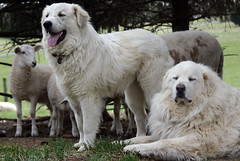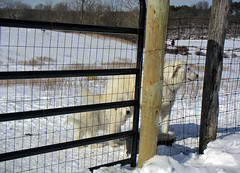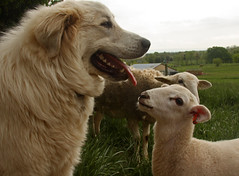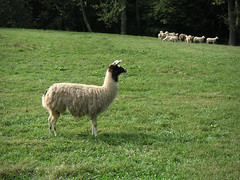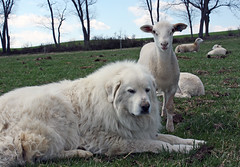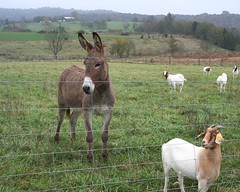- Sheep 201 Index
- Other web sites
Livestock guardians
According to a USDA NAHMS study, 45 percent of sheep farms in the United States use livestock guardians to protect their sheep and lambs from predation. Of those reporting the use of guardians, 29.6 percent use livestock protection dogs; 14.2 percent use llamas; and 11.4 percent use donkeys.
Guardian Dogs
Guardian dogs (or livestock protection dogs) are the most popular livestock or flock guardian. Guardian dogs have been used for centuries to protect livestock. The breeds of dogs typically used to guard sheep originated in Europe and Asia. They include the Great Pyrenees (France), Komondor (Hungary), Akbash and Anatolian Shepherd (Turkey), Maremma (Italy), Polish Tatra (Poland), and Mastiff (Spain and Tibet).
These dogs are typically large (80-120 lbs) white or fawn colored with dark muzzles. Some breeds (e.g. Komondor) are considered to be more aggressive than others (e.g. Great Pyrenees). Mixed breeds can be just as effective as purebred guardian dogs. Research has shown there is little difference in effectiveness among breeds. Greater variation exists within breeds.Guardian dogs work by staying near the sheep and aggressively repelling predators. Under range conditions or with large pastures, more than one dog may be necessary. Guardian dogs work best in pairs. Neutering of males or females does not seem to dimish their guarding capability. Nor does sex seem to matter. Males and females are equally effective.
Genetics and rearing are the key factors that affect a guardian dog's effectiveness. When purchasing a guardian dog puppy, it is important to purchase from a reputable breeder. Guardian dog pups should be raised with sheep, with minimal human contact. A guardian dog's job is to bond with the sheep, not the shepherd. Guardian dogs are generally aloof towards strangers.
Research and surveys have indicated that about 75 percent of guardian dogs are effective.
Llamas
A single llama should be used so that it will bond to the sheep and not other llamas.
Llamas can offer an effective, long-term, economical alternative for predator control. They are particularly aggressive towards dogs and coyotes. Llamas do not require training. Females or geldings (castrated males) are generally recommended over intact males. Females are very aggressive towards strange dogs. Intact males may try to breed the ewes and could cause injuries or death.A single llama is usually more effective in a pasture as some llamas may bond with each other and fail to protect the flock. Llamas should be introduced to sheep in a small pasture or corral. They do not need to be raised with sheep to be effective. Human contact with a guard llama should be avoided.
There are many advantage to using llamas as livestock guardians. Their care and feeding is similar to sheep. They do not require special feeds. They are live long and are less prone to accidental death. They do not wander, dig, or bark.
In Australia and Europe, Alpacas are being used as flock guardians.
Donkeys
A donkey's natural herding instinct and inherent dislike and aggressiveness towards coyotes and dogs make it a suitable guardian for sheep flocks. Given ample opportunity, most donkeys will bond with sheep and protect them from predators. If the donkey isn't raised with sheep, it should be housed next to the sheep for 1 to 2 weeks.
Donkeys rely on sound and sight to detect predators. The donkey's loud bray and pursuit will scare away predators and may also alert the shepherd. If the predator does not quickly flee, the donkey will attack by rising up on their hind legs and striking with both front feet.
A jenny and foal probably provide the best protection; however, jennies also work well on their own. Geldings are also effective and oftentimes preferred because of their even temperament. Intact males are oftentimes too aggressive with the sheep and people.Donkeys are best suited to flocks having less than 100 ewes. Not all donkeys make good guardians. Some are too aggressive with the sheep. While all donkeys dislike canines, the miniature donkeys may be too small to provide adequate predator control. It is generally recommended that medium to larged sized donkeys be used as livestock guardians.
Like llamas, donkeys are long-lived and have minimal upkeep, although they need different shots than sheep. In addition, they need to kept away from feeds that contain coccidiostats (Rumensin®, Bovatec®, and Deccox®), as these compounds can be poisonous to equines.
Cattle
There may be some benefit to grazing cattle and sheep together. Cattle can serve as natural protectors. A mixed group of cattle and sheep is called a "flerd." The challenge is getting the two species to bond together. If the sheep have bonded with the cattle, they will seek protection in the flerd if they are threatened. If they have not bonded to the cattle, they will form their own group independent of the cattle when they are threatened.
Which Guardian Is Best?
The best guardian is the one that works. Guardian dogs, llamas, and donkeys have all used successfully to prevent or reduce predation in sheep flocks. At the same time, not all guardian dogs, llamas, and donkeys make suitable guadians. There are advantages and disadvantages to each type of guardian. Guardian dogs effectively deter coyote and dog predation on fenced pastures as well as open range. Llamas and donkeys are considered to be best suited to fenced pastures.
Guardian dogs are more effective at detering bear and mountain lion predation, as llamas and donkeys appear to be afraid of larger predators. Furthermore, it is important to understand that livestock guardians are not a cure-all for predator problems. While they can be the first line of defense, they need to be supplemented by other control methods.
<== SHEEP 201 INDEX
Copyright© 2021. Sheep 101 and 201.

